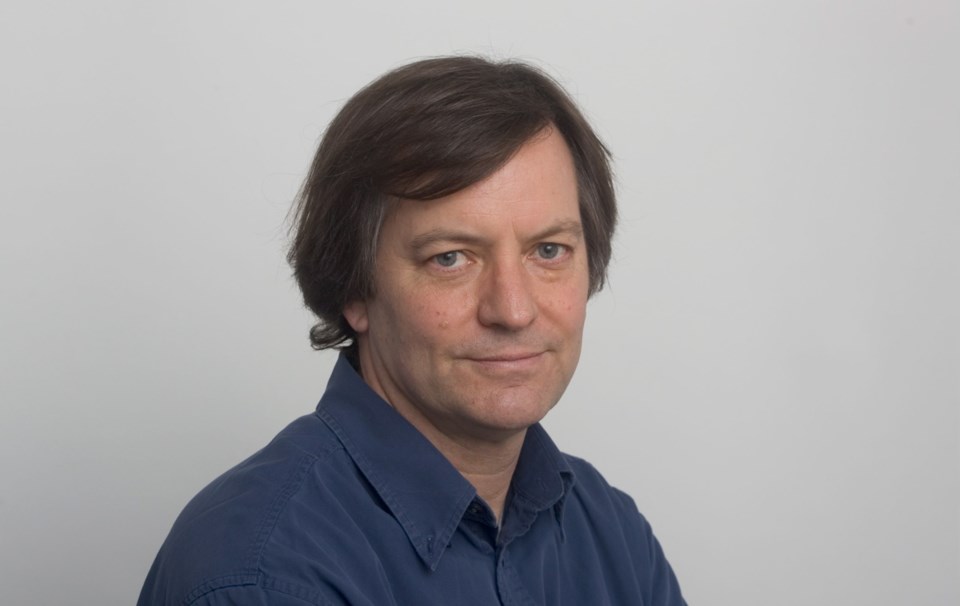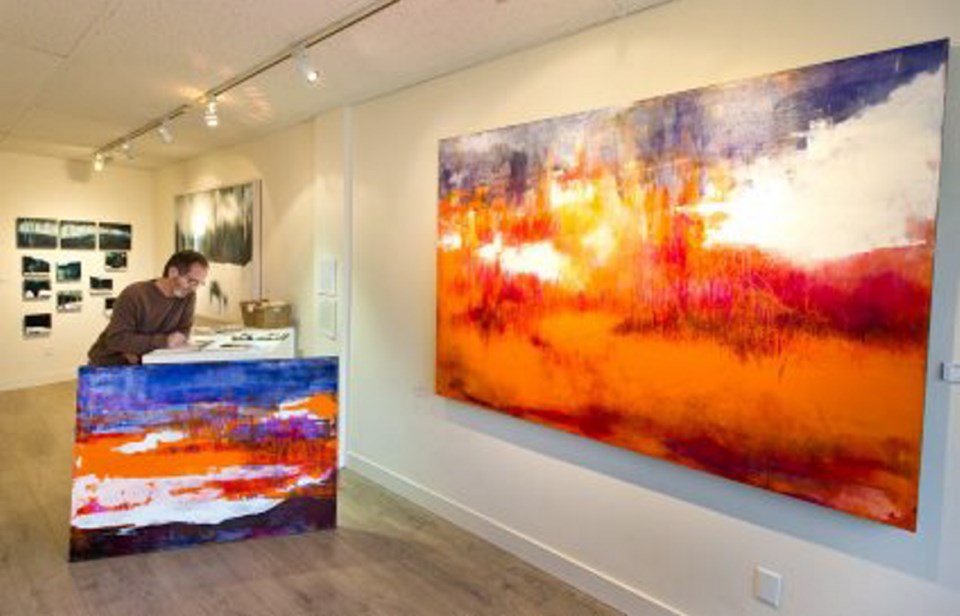 Shelby Assenheimer is a member of the Gage Gallery, a collective of 19 artists with their own gallery at 2031 Oak Bay Ave. I interviewed her there amid her big, bold canvases.
Shelby Assenheimer is a member of the Gage Gallery, a collective of 19 artists with their own gallery at 2031 Oak Bay Ave. I interviewed her there amid her big, bold canvases.
Gage Gallery began two years ago. At that time, members Arlene Nesbitt and Diana Durand approached Assenheimer, when she was participating in the Scattered Artists Studio Tour from her home on Tattersall.
“The Gage Gallery is a way of artists coming together, a creative group where we can learn from each other,” she noted. Members get a solo show once every 18 months, and also show in occasional group shows. “Since we all work together, there is a cohesiveness that begins to develop.” It’s all the more interesting because the artists are diverse.
Assenheimer also exhibited at the late lamented Atelier 546 on lower Yates. Her large-in-scale, decorative-in-effect worked very well in that dramatic space.
“I have done interior design work,” she acknowledged. “I’m not trained,” she admitted, “but in the early ’90s my brother put together a restaurant in [Vancouver’s] Metro Town, called Tuscany. And he hired me to do the interior. It was a huge job, from the wall finish right down to the cutlery.”
“I absolutely loved it,” she said. “Finding all the artisans and the sub-trades and putting the whole thing together. And I love the food culture — it’s part of our family. My mom was one of five sisters — they were all sewing and cooking — very creative and artistic. There were a lot of artistic family members: musicians, architects and so on. It was just part of the way we lived.”
At that time, Metro Town was the trendy place to be, and soon she worked for the Keg, and the Trolls at Horsehoe Bay, and Cookies by George, all of which came to her by word of mouth. This was the time when faux finishing was in fashion, and Assenheimer often did that work herself.
“It comes through in the layering in my paintings, which I use for getting the depth. I’m a hands-on person and, for those restaurants, I poured coloured concrete, or was up in the rafters helping my husband build.” This work experience opened up new worlds for her.
“I had spent many years observing the world and the seasons, and the imagery was all there, ready to come out.”
Painting walls also made her comfortable creating on a large scale. Then the video titled Gerhardt Richter Painting opened another door.
She saw that the German artist painted with a printers’ squeegee, and Assenheimer’s “very supportive” husband made one for her. He’s a carpenter, and he too is very creative. He inspired her with his attitude: “Well, do it! Get out there and do it! Don’t hold back.”
He’s not worried if it doesn’t work, she said. Do something else!
She began painting with acrylic in 2001.
“We built a home and needed some artwork for the walls, so I painted a few big canvases. I never thought of showing my work. It was just practical, like making the curtains.” Before long, she joined the Scattered Artists tour. Then Barb Adams invited her to take part in the Artishow movement, which arranged for her to be artist in residence at the Laurel Point Inn last August. To her delight, she sold four paintings there, including sales to London and Seattle customers.
When Assenheimer first approaches a fresh canvas, she is just playing, adding layers of glazes and operating in a completely abstract realm. Then she starts with some mark-making, often using the edge of the squeegee to inscribe crisp lines, while for softer marks she uses a paint brush. I suggested she had the freedom to “fool around” this way only because she didn’t go to art school. That drew a laugh.
“Right now I’m going to VISA [Vancouver Island School of Art]. I want to get the words behind what I do. People ask me, but much of what I do is intuitive. I get into that zone and the painting propels itself. Things I have experienced in life — they just come through.”
It’s at this point in the painting process that the artist questions herself. What am I doing? Where am I going?
“But I find my way,” she smiled. “I’m at a point now where I don’t get worried in the middle of a painting. I know it will eventually come out.”
Many of her current paintings are almost black and white, inspired by driving across Saskatchewan in the winter. She recalled that she had seen single horses there, “standing alone, in the middle of nowhere,” and somehow staying alive. And this brought to mind her English grandparents, who homesteaded in Saskatchewan.
“They started out in sod huts. How did they survive?” she pondered. “And I was attracted to all that white.”
The sky in these paintings, perhaps stormy or simply night time, is almost blue black. Cutting across the large horizons are verticals set up by prairie trees. This adds up to a simple vertical/horizontal colour field painting — plus a horse.
I asked if she loved horses.
“They’re not a part of my life. Never have been,” Assenheimer told me. But for her paintings, she likes “a little bit of a story in there.” So each has a horse.
“But it’s not about the horse,” she insisted. “That’s not what the story is about. The horse is a tool to help tell the story, to bringing out the feelings of what it’s like to live in a harsh environment. To accept what the climate throws at you. To live with it and to move on — and to still be you.”
As we talked, I discovered more of her attitudes and opinions, but Assenheimer is determined to leave the message open, for each viewer to respond in their own way. Between décor and message, abstract and representation, these confident canvases keep the viewer engaged.
Shelby Assenheimer at Gage Gallery (2031 Oak Bay Ave., , 250-592-2760) until Feb. 6.



